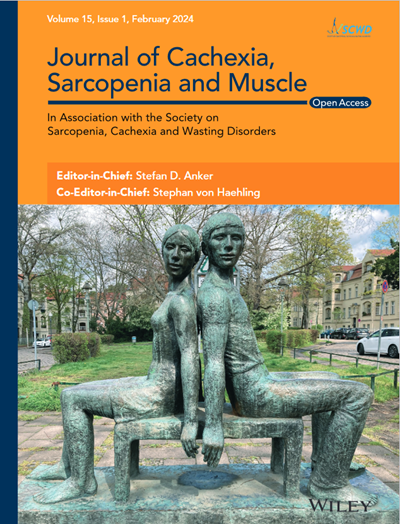肌肉减少症与椎间盘退变的长期风险之间的关系
IF 9.1
1区 医学
引用次数: 0
摘要
背景:骨骼肌减少症和椎间盘退变(IDD)在老年人中都非常普遍,并对他们的生活质量产生重大影响。然而,肌少症与缺碘症之间的关系尚不清楚。本研究旨在调查肌肉减少症是否与中老年人IDD风险增加独立相关,使用来自英国生物银行的前瞻性数据。方法根据欧洲老年人肌肉减少症工作组2 (EWGSOP2)的标准,共纳入378 773名来自英国生物银行的参与者,并将其分为三组:正常、可能和确诊的肌肉减少症。使用Kaplan-Meier生存分析和Cox比例风险模型检验肌肉减少症和IDD之间的关系。敏感性分析包括亚组分析以评估结果的稳健性,以及相互作用试验以探索潜在的效应调节因子。结果研究对象年龄中位数为59岁,女性占54.8%。在171个月的中位随访期间,10585名参与者患上了IDD。在未调整的Cox回归分析中,与正常组相比,可能肌少症组IDD的风险比(hr)为1.51 (95% CI: 1.41-1.61),确诊肌少症组为1.47 (95% CI: 1.14-1.90)。在调整多个协变量后,相应的hr分别为1.35 (95% CI: 1.26-1.44)和1.41 (95% CI: 1.10-1.80)。这些关联在亚组分析中保持一致。值得注意的是,在BMI分层分析中,与BMI≤25 (HR: 1.51; 95% CI: 1.06-2.16)的个体相比,肌肉减少症和BMI≤25的个体患IDD的风险更高(HR: 1.88; 95% CI: 1.31-2.71),两者之间存在显著的相互作用(p < 0.001)。结论:肌肉减少症与缺乏症的风险增加有关,特别是超重或肥胖个体。定期评估肌肉力量和质量,同时促进老年人的身体活动和适当的营养干预,可能有助于预防肌肉减少症和延缓IDD的发病。本文章由计算机程序翻译,如有差异,请以英文原文为准。
Association Between Sarcopenia and the Long‐Term Risk of Intervertebral Disc Degeneration
BackgroundSarcopenia and intervertebral disc degeneration (IDD) are both highly prevalent among the elderly and have a substantial impact on their quality of life. However, the association between sarcopenia and IDD remains unclear. This study aimed to investigate whether sarcopenia is independently associated with an increased risk of IDD in middle‐aged and older adults, using prospective data from the UK Biobank.MethodsA total of 378 773 participants from the UK Biobank were included and categorized into three groups based on the European Working Group on Sarcopenia in Older People 2 (EWGSOP2) criteria: normal, probable sarcopenia and confirmed sarcopenia. The association between sarcopenia and IDD was examined using Kaplan–Meier survival analysis and Cox proportional hazards models. Sensitivity analyses included subgroup analyses to assess the robustness of findings and interaction tests to explore potential effect modifiers.ResultsThe median age of participants was 59 years, with females accounting for 54.8% of the cohort. Over a median follow‐up duration of 171 months, 10 585 participants developed IDD. In unadjusted Cox regression analyses, compared to the normal group, the hazard ratios (HRs) for IDD were 1.51 (95% CI: 1.41–1.61) in the probable sarcopenia group and 1.47 (95% CI: 1.14–1.90) in the confirmed sarcopenia group. After adjusting for multiple covariates, the corresponding HRs were 1.35 (95% CI: 1.26–1.44) and 1.41 (95% CI: 1.10–1.80), respectively. These associations remained consistent across subgroup analyses. Notably, in BMI‐stratified analyses, individuals with sarcopenia and a BMI > 25 had a higher risk of IDD (HR: 1.88; 95% CI: 1.31–2.71) compared to those with BMI ≤ 25 (HR: 1.51; 95% CI: 1.06–2.16), with a significant interaction (p < 0.001).ConclusionsSarcopenia is associated with an increased risk of IDD, particularly in overweight or obese individuals. Regular assessment of muscle strength and mass, along with promoting physical activity and adequate nutritional interventions in ageing populations, may help prevent sarcopenia and delay the onset of IDD.
求助全文
通过发布文献求助,成功后即可免费获取论文全文。
去求助
来源期刊

Journal of Cachexia, Sarcopenia and Muscle
Medicine-Orthopedics and Sports Medicine
自引率
12.40%
发文量
0
期刊介绍:
The Journal of Cachexia, Sarcopenia, and Muscle is a prestigious, peer-reviewed international publication committed to disseminating research and clinical insights pertaining to cachexia, sarcopenia, body composition, and the physiological and pathophysiological alterations occurring throughout the lifespan and in various illnesses across the spectrum of life sciences. This journal serves as a valuable resource for physicians, biochemists, biologists, dieticians, pharmacologists, and students alike.
 求助内容:
求助内容: 应助结果提醒方式:
应助结果提醒方式:


